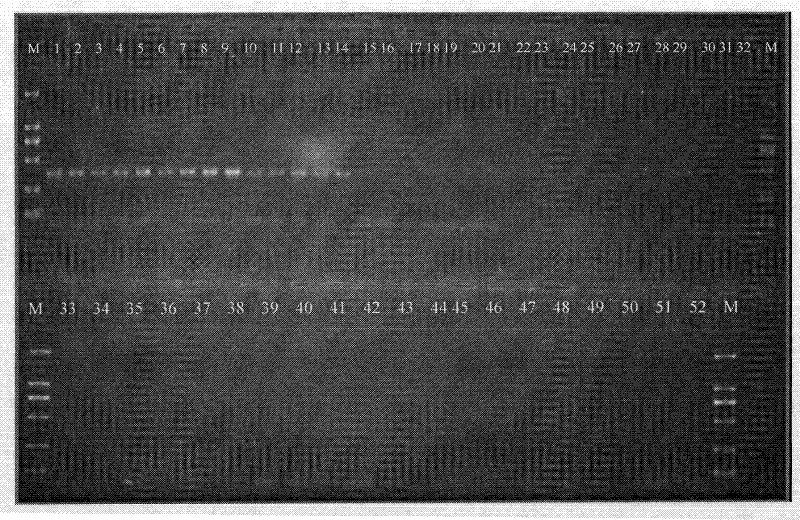Specific gene sequence of tilletia controversa kuhn, specific SCAR marker and PCR detection method
A technology of dwarf black powder fungus and wheat dwarf black ear, which is applied in the biological field, can solve problems such as failure to separate, and achieve the effects of high detection sensitivity and reliability, and high practical application value.
- Summary
- Abstract
- Description
- Claims
- Application Information
AI Technical Summary
Problems solved by technology
Method used
Image
Examples
Embodiment 1
[0047] Embodiment 1: screening the specific ISSR specific primers of T. tritici
[0048] 1.1 Extraction of T. tritici DNA
[0049] The improved CTAB / SDS method was used to extract the DNA of T. tritici.
[0050] (1) Sample pretreatment: Take one smut gall (about 10 mg), crush it and add it to a 2 ml sterilized screw centrifuge tube, add 25 mg diatomaceous earth, 250 mg sterilized glass beads with a diameter of 1 mm, and vortex Vortex to mix. Place at -20°C overnight.
[0051] (2) Water bath: Add 660 μl of preheated SDS / CTAB extraction buffer and 5 μl of proteinase K solution to the centrifuge tube, mix with a vortexer, and bathe in a constant temperature water bath at 65°C for 1 hour
[0052] (3) Grinding: Place the centrifuge tube in MP FastPrep-24, a rapid nucleic acid extractor, set at 6.5M / s, and process once every 10s.
[0053] (4) Extraction: take the supernatant, add an equal volume of chloroform / isoamyl alcohol mixed solution (24:1), and centrifuge at 15493×g for 10 ...
Embodiment 2
[0065] Example 2 Determination of Sequence of Specific Fragment of Tilletia tritici and Obtaining Specific SCAR Marker
[0066] According to the sequence sequencing results of the T. tritici specific fragments obtained in Example 1, the sequences were analyzed and compared with DNAMAN 5.2.2 software, and three pairs of TCK specialized SCAR primers TCKSF(1-3) / TCKSR (1-3). These primers can amplify bands of 372bp, 496bp and 419bp respectively in all TCK bacterial strains, but there is no amplification product such as Tilletia tritici and Tilletia tritici figure 2 , 5 , 7. Therefore, the above three fragments are specific SCAR markers of T. tritici.
[0067] The sequences of primers TCKSF(1-3) and TCKSR(1-3) are as follows:
[0068] TCKSF1 (5'-TGG TGG TCG GGAAAG ATT AGA-3')
[0069] TCKSR1 (5'-GGG ACG AAG GCA TCA AGA AG-3')
[0070] TCKSF2(5'-TTG CTG GCT CTT CGC CCT GA-3')
[0071] TCKSR2 (5'-TTG CCC GTC TTG CGG TTG AT-3')
[0072] TCKSF3 (5'-CACACACACACAGGAAGCA-3')
...
Embodiment 3
[0074] Example 3: Verification of Tilletia tritici-specific SCAR markers
[0075] The TCKSF(1-3) / TCKSR(1-3) specific SCAR marker primers TCKSF(1-3) / TCKSR(1-3) for T. tritici constructed in the present invention were synthesized by Shanghai Biological Engineering Company, and the total volume of the amplification reaction system for specific SCAR markers was 25 μl, wherein Contains 10×PCR-buffer 2.5μl, Mg 2+ 2μl (25mM), dNTPs 0.3μl (10mM), TCKSF (1-3) / TCKSR (1-3) each 1μl (10μM), Taq DNA polymerase 0.3μl (2.5U / μl), template DNA (wheat dwarf fishy black 1 μl (20ng / μl) of DNA extracted from powdery mildew, Tilletia tritici and Tilletia tritici, and 25 μl in sterilized double distilled water.
[0076] PCR amplification conditions were 94°C for 5min; 94°C for 30Sec, TCKSF1, 3 / TCKSR1, 3 55°C for 30Sec (TCKSF2 / TCKSR2 60°C for 30Sec), 72°C for 1min, 30 cycles; 72°C for 10min; 4°C forever. After PCR amplification, take 5 μl of the amplified product and add 1 μl of sample buffer to e...
PUM
 Login to View More
Login to View More Abstract
Description
Claims
Application Information
 Login to View More
Login to View More - R&D
- Intellectual Property
- Life Sciences
- Materials
- Tech Scout
- Unparalleled Data Quality
- Higher Quality Content
- 60% Fewer Hallucinations
Browse by: Latest US Patents, China's latest patents, Technical Efficacy Thesaurus, Application Domain, Technology Topic, Popular Technical Reports.
© 2025 PatSnap. All rights reserved.Legal|Privacy policy|Modern Slavery Act Transparency Statement|Sitemap|About US| Contact US: help@patsnap.com



